- Submissions

Full Text
Trends in Textile Engineering & Fashion Technology
Construction of an International Size Conversion Chart for Men's Sportswear
Kanjana S, Ambika Babu and Nalankilli G*
Ethiopian Institute of Textile and Fashion Technology, Bahir Dar University, Ethiopia
*Corresponding author: Nalankilli G, Ethiopian Institute of Textile and Fashion Technology, Bahir Dar University, Bahir Dar, Ethiopia
Submission: January 22, 2018; Published: February 15, 2018

ISSN: 2578-0271 Volume1 Issue3
Abstract
Size labeling is a communication system between manufacturers and consumers. Today's clothing industry, particularly for the sportswear is based on ready- to- wear sizes. Most of the size designations are not accurate enough to find clothing that fits our body. The increasing shift from shop tailing to e-commerce has been a major impact on fit in terms of sales and higher return, not only because of sizes and measurements, but because of so many brands have their own disparities within clothing sizes used today among different countries. In this study, major men's sportswear particularly top- wear size charts that are available in the web, of top most 5 popular brand manufacturer such as Nike, Adidas, Fila, Reebok & Puma which are categorized based on their profits gained in 2016, were collected. Similarly, five major online purchasing countries like USA, UK, South Korea, France and Germany were taken for this study, based on a survey conducted in 400 online respondents. Categorization and evaluation of the same were done based on popular brand & countries. A critical examination and analysis were made. Finally, one universal size conversion chart has been developed by using all the information, which helps in minimising confusions and errors, from the customers and e-tailers perspective, by feeding the home country & size of the particular brand that will give the equivalent size of a brand of these desired countries and vice-versa. Right fit of a garment enhances confidence, comfort as well as performance & efficiency while sporting.
Keywords: Sportswear; Sampling; Size chart; Label; Conversion table
Introduction
Dressing requires finding clothes that fit our bodies and the way we look, as well as the society and occasions we are part of [1]. The fit of a garment contributes, among other things, to the confidence and comfort of the wearer [2]. Most importantly, for sportswear the right fit garment influence the efficiency and performance of the wearer during sport. Today's apparel industry is based on a system where clothes are made in Ready- To- Wear (RTW) sizes. The industry faces challenges as RTW clothes are supposed to fit a variety of bodies while at the same time balancing economic and practical limitations in production and profitability. It is costly to produce clothes in several different sizes, and therefore the industry concentrates the selection of sizes to fit the target customer groups.
Most of the Sports garments are made up of Ready-To-Wear clothing. During sports, the way they are dressed to represent for their country that will give them more proud [3]. They feel their dressing will also give dignity to the nation where they have represented for.
Development of size designation systems and ready-to- wear clothing
Ready-To-Wear clothing has existed since the industrial revolution. Previously, clothes were made to fit each individual either by the wearer themselves, family members or professional dressmakers or tailors. The first grading systems were the proportional dressmakers' systems used between 1820 and 1838. They used a single body measurement, such as bust measure, from which the other pattern dimensions were then graded in equal proportions [4]. These were based on tailors' experience and not on scientific anthropometric studies.
During the first half of the twentieth century, British sizing was often organized by 2 inch division in the bust, waist or hip size and sets of size designation codes were used. Already then the different size designation systems were considered confusing, and efforts were made in the later part of the twentieth century, both in the US and Europe, to develop standardized sizing through body measurement surveys and the use of statistical methods [5]. The first scientific size charts were published by the British Standards Institution (BSI), including a set schedule of code sizing related directly to body measurements in 1953. In the US, the first standard clothing sizes, CS 215-58, were published in 1958 (US Department of Commerce). Development of an international sizing system for clothing started in 1969 and the first international standard for clothing size designations, including definitions and body measurement procedures, was finally published in 1977 [6]. The European committee for standardization has adopted a modified version of this standard in to their work [7] and is now working to develop a new European size designation system [8]. They have experienced problems in reaching a common size code, it has to be informative and indicate sizes accurately, but at the same time not too complicated for the consumers from different nations to understand or for the apparel industry to use [9].
Fit problems with size designations
Size labelling is a communication system between manufacturers and consumers. The purpose of the system is to make it simpler for the consumers to find clothes that fit. The following 3 things are more important, the manufacturers must label the sizes correctly, the consumers must understand and trust the size labelling and the clothes must fit the consumers' bodies. The material revealed flaws in all these three areas. Producers label the clothes incorrectly sometimes [10].
Several studies have shown that there are disparities within clothing sizes used today. The most obvious disparities are the national labeling differences between countries [11] found that there were significant differences even though clothing would have the same size designation. For sports garments, these problems are quite common and there are differences between brands also. The sizing differences are not only a problem within the international markets, but also on a national level, region level as great disparities can be found within sizes.
Today, many consumers express frustration over the sizing systems and the incorrect use of the system. Several consumers report the need to actively seek out different apparel brands in order to identify brands that sell clothes that fit their body size and type [12]. Such frustration is typical of how sizing systems are experienced today, it is complicated to find clothes that fit the body.
Sport can be played anywhere in the world and if anyone wanted to purchase a sportswear in some other country, it is very difficult to choose his desired size as the size label designation is confusing, that is meant for home country/region. Sportswear or any garments are made according to the sizes of their region, area as well as country. Universal standardization of sizes is not easy as human body proportions are varying among regions/countries. Giving all information in the size label are also confusing while choosing right fit garment. Size charts/size standards developed so far are for particular region people/ or particular country which is not suitable for other countries/other regions. For example, size designation in the size label 'L' is for chest measurement 44 inches in India is different size for Chinese there 'L' means 38 inches of chest measurement.
To overcome this problem, a conversion chart will be useful, like other conversion charts by feeding our desired size or any familiar sizes that will give the equivalent size of local designation or vice versa. Thus, the researcher developed a universal size conversion chart of men's sportswear category for top wear in which they tried to narrow down the differences between top brands and top online shopping countries. Using this converter a sport person can choose his desired brand/clothing of his exact body size wherever he goes.
Problem statement
Size labelling is a communication system between manufacturers and consumers. Today’s clothing industry, particularly for the sportswear is based on ready- to-wear sizes. Most of the size designations are not accurate enough to find clothing that fits our body. Several studies have shown that there are disparities within clothing sizes used today. The most obvious disparities are the national labelling differences between countries. The identification between size codes and body ideals becomes more complex as the size labels are not directly indicating the body measurements. There were significant differences even though clothing is the same size designation and is very common in Brand to Brand. Most of the researchers have experienced problems in reaching a common size code as the bodies proportions are vary according to the geographical divisions. Right fit of a garment enhances confidence, comfort as well as performance & efficiency while sporting.
To overcome this problem, we are trying to develop one simple, unique, universal size conversion chart using data that are collected from web data, popular sportswear manufacturers, retail outlets, clothing stores etc., after critical evaluation.
Background & justification
Sizing of clothing, for all intents and purposes, is an arbitrary protocol designed by someone in the apparel creation-supply chain to sell products to more people. We use the term 'someone' because it could be almost anybody, or in some cases, nobody. There are a significant number of fashion brands, importers and retailers who, basically, buy what they like from vendors on the open market and then re-sell that product to their customers.
These 'buyers' generally have no say, or even interest, in the sizing specifications, grading or protocols of the product they are selling; and, since they buy from multiple vendors, they often get very different sizing - not a good thing for building customer loyalty perhaps, but for many of these buyers, especially those in the 'fast fashion’ arena, often considered 'disposable' fashion, fit is not their value proposition. Rather, what is hot, new and just off the runway, at an unbelievably low price, is their value proposition and they generally get away with whatever fit and sizing they have, no matter how much it varies.
Every brand tries to strike that perfect balance, having a range of sizes that covers the most people possible, with the fewest number of sizes, all the while trying to ensure that sizes are not so close together that consumers cannot tell the difference (we will discuss the impact of sewing tolerance on this shortly), and not so far apart that a high percentage of consumers find themselves 'between sizes' where one size is too small and the next size too large to provide a flattering fit. This is of particular concern with alpha, or letter-sizing; the intervals between S, M, L sizes are typically double the intervals between numeric sizes (such as 8, 10, and 12). While this is perfectly normal and acceptable for certain types of styles and fabrics (knit tops or sweaters, for instance, due to the amount of stretch in the fabric and drape intent of the product), brands risk losing sales if their grade intervals are too far apart.
These size protocols may have some commonalities within particular countries but vary widely around the world. In the US, for example, the majority of women's brands offer sizes 4 through 16, with many offering smaller sizes (2, 0, even 00) and larger sizes (18, 20, and then plus sizes).
Methodology/Research Approach
Developing a universal size converter for men's sportswear (top wear) category, needs, available standard sizes in the categories such as different countries and different top brand sportswear manufacturers. We have collected all these size information by a consumer survey supplemented with interviews, market analysis on availability of sizes. Some in-depth interviews were conducted in order to obtain more profound data than could be supplied by the web survey. Web based survey, Market research of size selections and in-store clothing measurements contributed with information are the major sources for our study.
Collecting data
For collecting data, following three methods such as Quantitative Data, Qualitative Data and Market Research have been used.
Method 1: Quantitative data
Data of consumers' experiences and opinions concerning size labeling and online shopping was collected through a web-based survey in all countries with clothing purchases including the search for the correct size, as well as experiences with different size designation systems. The available size charts for men's top wear of all top branded sports manufactures were collected through web.
Method 2: Qualitative data
The survey was subsequently supplemented with in-depth half-structured interviews in order to gather information about customers’ experiences with the size labelling systems. Size data were collected from sports persons who are all visiting the above said online shopping.
Selecting top brand sportswear manufacturer
Researchers have selected the brand for the study based on their revenue and the profit of 2016 and Nike comes first in terms of m$ (Revenue12377 & Profit 1232) followed by Adidas (Revenue 18606.5 & Profit 792), Puma (Revenue 30601& Profit 792), Reebok (Revenue 7605 & Profit 572), Fila (Revenue 7,270 & Profit 330), Under Armor (Revenue 3963.313& Profit 233), Jordon (Revenue 3147 & Profit 93.1567), Columbia Sportswear (Revenue 2326 & Profit 174.337), ASICS (Revenue 3899.314 & Profit 792) and Converse (Revenue 3725.7& Profit 40.7), based on the profit analysis of 2016, conducted by http:// www.mbaskool.com/fun- corner/top-brand-lists/16272-top-10-sportswear-brands-of-the- world-2016. Html.
As per the profit analysis of 2016. Conducted by http:// www.mbaskool.com/fun-corner/top-brand-lists/ 16272-top-10- sportswear-brands-of-the-world-2016. html. (Figure 1)
Figure 1: Selection of sportswear brands for the study.

Selecting the countries for the study
Figure 2: Selection of the countries for the study based on the survey conducted @ www.dw.com.
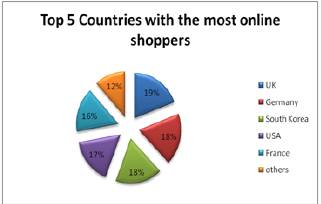
In Figure 2, Out of 400 respondents, 77(19%) of them are of United Kingdom customers shop online which are more than the actual physical shops, followed by the countries are Germany 74(18%), South Korea 72(18%), USA 66(17%), France 64(16%) and other countries 47(12%) of replied.
Clothing stores in the USA, UK, South Korea, France and Germany were also visited online in order to study and collect the availability of clothing in different sizes of Nike brand sportswear in men's top wear category.
Data analysis
Collected data were critically examined and the right size information’s were picked among them. Random sampling technique was followed for choosing the required size information among the collected and segregated. In our study, since Nike brand being trading in all these five Countries based on availability of the sizes in the market, we found that as in Figure 3.
Analysis of NIKE brand: Nike is an international brand and the sizes which they offer to the customers are XS, S, M, L, XL, XXL & XXXL in France, Germany and United States of America, South Korea has 4 size categories like S, M, L & XL and United Kingdom has 6 sizes XS, S, M, L, XL& XXL (Figure 3).
Figure 3: Sizes available online for the brand Nike in different countries.
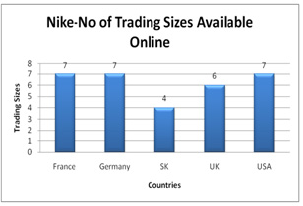
The following assumptions were made from the findings
a) Assumption 1: Among 5 countries majority of the countries offer 7 sizes, for analysis researchers have taken large size which is found to be the middle of 7 size categories.
b) Assumption 2: In online size guide the parameters are in class intervals so the data is considered a start of interval as minimum range and end of the interval as maximum range of size number.
Figure 4: Comparison chart between the countries based on chest measurement-large size.
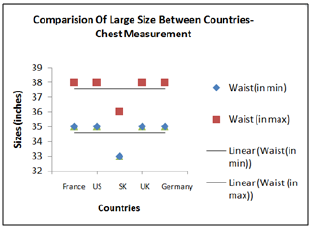
Figure 4 & 5 show, for both chest and waist measurements, France, US, UK and Germany follows the same pattern whereas SK only deviates. In Figure 6, we found the odd group of countries like UK and SK also having variations among the maximum chest measurements in the large size.
Analysis of Adidas brand: Figure 7 & 8
Analysis of Fila brand: Fila offers 7 Sizes such as XS, S, M, L, XL, 2XL & 3XL in all these 5 countries. (Figure 9)
Analysis of Reebok brand: Reebok offers 7 Sizes such as XS, S, M, L, XL, 2XL & 3XL in all these 5 countries (Figure 10).
Figure 5: Comparison chart between the countries based on waist measurement-large size.
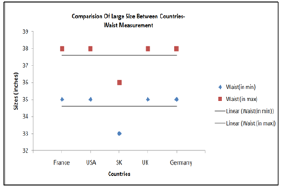
Figure 6: Comparison of large size between South Korea and United Kingdom.

Figure 7: Sizes available online for the brand adidas in 5 countries.
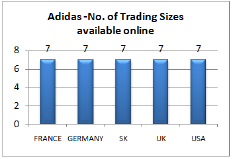
Figure 8: Comparison of chest & waist measurements l size of adidas brand.
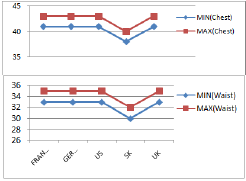
Figure 9: Comparison of chest & waist measurements l size of fila brand.
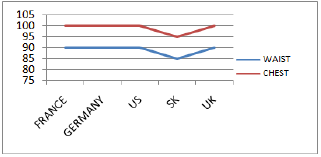
Figure 10: Comparison of chest & waist measurements l size of reebok brand.

Analysis of Puma brand: It offers 7 sizes XS, S, M, L, XL, 2XL & 3XL in all these 5 countries (Figure 11).
Figure 11: Comparison of chest & waist measurements l size of puma brand.

Establishment of universal size conversion chart converter
The researchers have concluded that the Nike being an international brand, they follow the same size guide among the 3 countries and except the South Korea and United Kingdom. As the researchers have seen from the analysis, South Korean measurement chart differences from other 4 countries due to their body propositions which differs from other 4 countries. For example, if a South Korean travel to USA and wanted to purchase a 'Nike t-shirt' he might find it difficult till before a universal size converter has been established.
A Universal Size conversion chart for Nike and Adidas brands for 5 countries has made after using all these information's in Excel sheet as in Table 1 & 2 for the quick and easy access of the customer, a programme has been formulated if anyone can feed the necessary input in the window for example, home country, brand, home size and desired country, then the output window shows the equivalent size of the buying country i.e. desired country’s size (Table 1 & 2).
Table 1: Universal size chart for Nike.

Table 2: A universal size table for Adidas brand.

For Puma, Reebok & Fila brands the similar type of Universal Size Chart are developed as in the case Adidas brand by using size information's from analysis 3, 4 & 5.
Following are the steps to use the universal size converter
Stepl: Select the Home country (Figure 12)
Figure 12: Select the home country.
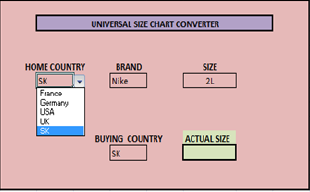
Step 2: Select the Brand which you want to buy (Figure 13)
Figure 13: Select the brand which you want to buy,
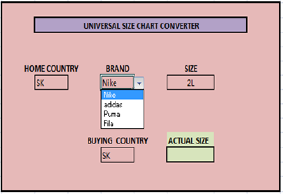
Step 3: Select the size which you usual buy in your home country (Figure 14)
Figure 14: Select the size which you usual buy in your home country.

Step 4: Select the country from which country want to buy (Figure 15)
Step 5: The converter show the Actual size which you have to purchase in that country.
Similarly, we have developed Universal Size converter for Adidas, Puma, Reebok & Fila brands.
Figure 15: Select the country from which country want to buy,

Conclusion
Thus, the Researchers developed a universal size converter of men's sportswear category for 5 top wear of Nike, Adidas, Fila, Reebok & Puma brands, like other conversion charts by feeding our desired size or any familiar sizes that will give the equivalent size designation of local country's or vice versa, in which it narrows down the differences between nations. Using this table a sport person can choose his desired brand/ clothing of his exact body size wherever he goes. In this study, the Researchers have tried only sportswear of top wear category, it is very useful for the consumers and manufacturers if all the categories have the similar conversion charts. In future, researchers may extend their research in universal standardization of sizes, revised size charts that become customer & manufacturer friendly.
References
- Adam Briggs (2000) The fashioned body: fashion, dress, and modern social theory, joanne entwistle. Journal Fashion Theory 5(2).
- Alexander M, Lenda JC, Ann BP (2005) Clothing Fit Preferences of Young Female Adult Consumers. International Journal of Clothing Science and Technology 17(1): 52-64.
- Ashdown SP (2007) Developing effective sizing systems for ready-to- wear clothing, sizing in clothing. Wood head Publishing Limited and CRC Press LLC, India.
- Kidwell, Claudia B (1979) Cutting a fashionable fit: dressmakers' drafting systems in the United States. Smithsonian Institution Press, USA.
- Aldrich, Winifred (2007) History of sizing systems and ready-to-wear garments. In: Ashdown SP (Ed.), Sizing in clothing: developing effective sizing systems for ready-to-wear clothing”, Cambridge, Wood head Publishing Limited, India, pp. 1-56.
- ISO 3635 (1977) Size designation of clothes-definitions and body measurement procedure. International Organization for Standardization, Switzerland.
- EN 13402-1 (2001) Size designation of clothes-Part 1, Terms, definitions and body measurement procedure (ISO 3635:1981 modified). European Committee for Standardization.
- (2007) Size designation of clothes-Part 4: coding system', in european committee for standardization, [prEN 13402-4): 'prEN 13402-4.
- Kirsi L, Ingun GK, Benedicte H (2011) Materialised ideals: sizes and beauty, culture unbound. Journal of Current Cultural Research 3: 19-41.
- Sandra B (2012) Developing an effective sizing system for global apparel companies. AMFI, Asian Sizing, Bachelor Thesis.
- Jongsuk CY, Cynthia RJ (1993) Garment-sizing Systems, An International Comparison. International Journal of Clothing Science and Technology 5(5): 28-37.
- La Bat, Karen L (2007) Sizing standardisation, developing effective sizing systems for ready-to-wear clothing. In: Ashdown SP (Ed.), Sizing in Clothing, Cambridge: Woodhead Publishing Limited, India, pp. 88107.
© 2018 Kanjana S. This is an open access article distributed under the terms of the Creative Commons Attribution License , which permits unrestricted use, distribution, and build upon your work non-commercially.
 a Creative Commons Attribution 4.0 International License. Based on a work at www.crimsonpublishers.com.
Best viewed in
a Creative Commons Attribution 4.0 International License. Based on a work at www.crimsonpublishers.com.
Best viewed in 







.jpg)






























 Editorial Board Registrations
Editorial Board Registrations Submit your Article
Submit your Article Refer a Friend
Refer a Friend Advertise With Us
Advertise With Us
.jpg)






.jpg)














.bmp)
.jpg)
.png)
.jpg)










.jpg)






.png)

.png)



.png)






